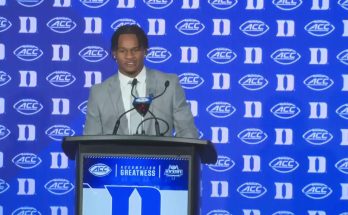Headline: Patience is a Virtue: Why It’s Too Early to Judge Terrion Arnold’s NFL Future
In today’s reactionary sports landscape, snap judgments have become the norm. First impressions are often treated as final verdicts, and the patience once granted to developing players is fading. This is especially true in the NFL, where rookies are expected to produce like veterans from the jump. But for every instant success story, there are dozens more of players who needed time, coaching, and experience to flourish. One of the latest subjects of overhasty criticism is Detroit Lions rookie cornerback Terrion Arnold.
Despite a rocky start in his debut season, it’s premature to write off Arnold’s future. As a seasoned observer of the game, I’ve seen this story unfold time and time again: a young talent stumbles early, endures the scrutiny, learns from it, and eventually evolves into a cornerstone of his team. The metrics might not currently favor Arnold, but history—and a deeper understanding of player development—suggests his story is far from over.
A Tough Rookie Campaign: The Numbers Behind the Struggles
Terrion Arnold’s transition from college star at Alabama to NFL rookie wasn’t seamless. While he displayed flashes of the ball-hawking ability that made him a first-round pick, inconsistency plagued his performances. According to Pro Football Focus (PFF), Arnold posted a coverage grade of 58.7 and an overall defensive grade of 60.2 in his rookie season—both below league average.
He allowed five touchdowns in coverage, committed six penalties, and opposing quarterbacks had a passer rating of 109.5 when targeting him. These numbers, though not egregiously poor, painted a picture of a rookie experiencing growing pains against elite competition.
In particular, Arnold struggled against route technicians. In matchups against wideouts like Justin Jefferson and Chris Olave, Arnold was frequently targeted and exposed. These experiences led to breakdowns in coverage and confidence lapses—symptoms often seen in first-year corners adjusting to the NFL’s speed and complexity.
Historical Precedents: Stars Who Struggled Early
Terrion Arnold isn’t the first rookie corner to stumble out of the gate, and he certainly won’t be the last. Consider the early careers of some now-elite NFL defensive backs:
- Jaire Alexander (Green Bay Packers): The now two-time Pro Bowler posted a PFF grade of just 64.5 in his rookie season and was flagged seven times. He didn’t emerge as a shutdown corner until Year 3.
- Marshon Lattimore (New Orleans Saints): While Lattimore had an exceptional rookie campaign statistically, his second season saw a noticeable regression, leading some to prematurely label him a one-year wonder. He bounced back to become a consistent Pro Bowl performer.
- Darius Slay (Detroit Lions): Slay was benched multiple times in his rookie season after surrendering big plays. PFF gave him a lowly 48.5 grade in 2013. Fast forward, and “Big Play Slay” has become a multiple-time Pro Bowler and respected veteran leader.
The point? Struggles in Year 1 are not the death knell for a cornerback’s career. In fact, for many, they’re part of the process.
College to Pro: Why the Transition is So Tough for Cornerbacks
Of all the positions in football, cornerback may be the most difficult to transition from college to the NFL. The responsibilities are immense, and the margin for error is razor thin. Corners must defend against the league’s fastest and most technically refined receivers—often without safety help, and with complex schemes dictating their every move.
At Alabama, Arnold often thrived in Nick Saban’s man-heavy defense, which demanded physical press coverage and disciplined technique. While that system prepared him well in some respects, the NFL level demands faster processing, superior footwork, and exceptional spatial awareness.
In Detroit, Aaron Glenn’s defense is nuanced. It requires corners to play both man and zone effectively, communicate pre-snap shifts, and adjust to disguised coverage shells. For a rookie, it can be overwhelming.
PFF Deep Dive: Context Matters
Though Arnold’s raw numbers may be underwhelming, PFF’s advanced analytics paint a more forgiving picture when placed in context. Consider:
- Tight Window Coverage Rate: Arnold ranked in the top third of rookie corners in tight window percentage, a sign that he was often in the right place, even if the result wasn’t favorable.
- Missed Tackle Rate: His missed tackle rate was just 7.1%, significantly better than average for rookie defensive backs, indicating solid fundamentals in run support and short-area defense.
- Coverage Snap Volume: Arnold was tasked with a high snap count—nearly 900 defensive snaps—an indication that Detroit’s coaching staff trusted him to learn on the fly, even through mistakes.
In many cases, PFF grades reflect outcome over process. A well-covered receiver who makes a freak catch can still cost a DB in the grading algorithm. When tape is evaluated holistically, Arnold’s positioning and awareness were better than raw stats suggest.
Mental Toughness and Character: Hallmarks of Growth
Another crucial aspect of Arnold’s profile is his maturity and resilience. At Alabama, he battled through adversity, including competition for starting reps and injury concerns. He never wavered and emerged as a leader on one of college football’s most demanding defenses.
Since entering the NFL, Arnold has taken accountability for his play and shown a willingness to learn. Teammates and coaches alike have praised his work ethic and film-room dedication. Veteran corner Cam Sutton noted during a mid-season press conference:
“Terrion doesn’t back down. He asks questions, he’s in the film room late, and he’s learning. He’s going to be special once it all clicks.”
This mental fortitude often separates the long-term stars from those who flame out early.
The Sophomore Surge: A Real Trend
Statistical trends also support the likelihood of a second-year leap. NFL cornerbacks tend to make their most dramatic improvement between Years 1 and 2. Consider:
- Patrick Surtain II: From a 66.4 rookie PFF coverage grade to 82.6 in his second season.
- Trevon Diggs: From allowing over 800 yards in coverage as a rookie to leading the league in interceptions his second year.
- Jaycee Horn: Injury-riddled rookie year, followed by lockdown performance in Year 2.
These improvements are tied to experience, improved technique, and increased familiarity with defensive schemes.
Lions’ Defensive Future: Arnold Still a Cornerstone
The Lions’ coaching staff remains bullish on Arnold’s long-term potential. Defensive coordinator Aaron Glenn, a former Pro Bowl corner himself, has gone on record saying:
“He’s got every tool you want—speed, physicality, instincts. What he’s learning now is how to master the finer points. That comes with reps. We believe in him.”
With veteran mentorship, improved scheme comprehension, and an offseason of focused training, Arnold is poised for a breakout. The Lions’ investment in his development—both in coaching and playing time—signals their confidence in his future.
What Fans Should Watch For in Year 2
As Arnold heads into his second NFL season, fans and analysts should focus on a few key indicators of progress:
- Reduced Penalty Count: A sign of improved technique and poise under pressure.
- Improved Zone Awareness: Recognition of route combinations and better spacing.
- Increased Ball Production: Even a small uptick in pass breakups and INTs will reflect improved anticipation and confidence.
- Snap-to-Snap Consistency: Fewer mental lapses and blown assignments.
The Lions are likely to tweak their defensive packages to play to Arnold’s strengths—more man coverage and situational bracket support, allowing him to thrive with confidence.



